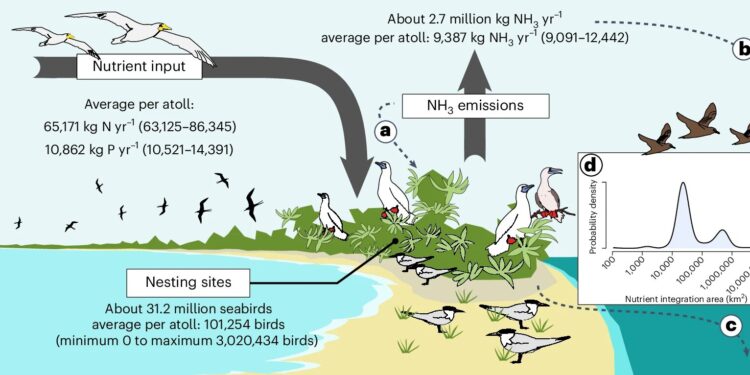The reciprocal relationship between seabirds and atolls. Credit: Nature Ecology and Evolution (2024). DOI: 10.1038/s41559-024-02496-4
A team of marine and avian biologists from the University of Auckland, Karolinska Institutet, the Nature Conservancy and the University of California conducted a large-scale study of birds nesting on Indo-Pacific atolls.
Their article is published in Ecology of nature and evolutionRuth Dunn of Heriot-Watt University published a News & Views article in the same issue of the journal describing the team’s work on the new effort.
Atolls are coral reef islands that originally formed around a volcano that over time sank into the sea, leaving the island behind. This is why atolls are usually ring-shaped. Previous research has shown that atolls are an important resource for seabirds: they provide a relatively predator-free place for these birds to feed, nest, and lay their eggs.
Previous research has also shown that seabirds are also important to atolls. Their droppings fertilize the soil and disperse seeds from distant locations. Despite the important role atolls play in the lives of millions of seabirds, little research has been done to determine how many birds nest there. For this new study, the research team conducted a large-scale survey of birds living on atolls in the Indo-Pacific region.
The team gathered information from more than 90 datasets on millions of seabirds in the region, including their nesting sites. The information also included data on seabirds nesting on 199 of the region’s 280 atolls.
They found that about 25% of all tropical seabirds nest on atolls. They also found that of the 14 species studied, more than half nest on atolls. They also found that atolls are breeding grounds for 37 species of seabirds, and their numbers on a given atoll can range from a few dozen to more than 3 million.
In total, they estimate that more than 31 million seabirds nest on atolls. They also found that the birds feed over an area of between 10,000 and 100,000 km² around a given atoll and deposit between 65,000 kg of nitrogen and 11,000 kg of phosphorus per atoll each year. Based on their findings, they suggest that atolls are even more important for seabirds than previously thought.
More information:
Sebastian Steibl et al, Atolls are globally important sites for tropical seabirds, Nature Ecology and Evolution (2024). DOI: 10.1038/s41559-024-02496-4
Ruth E. Dunn, Atolls are vital to seabirds and vice versa, Nature Ecology and Evolution (2024). DOI: 10.1038/s41559-024-02518-1
© 2024 Science X Network
Quote:Indo-Pacific atoll seabird study shows outsized impact on bird populations and nesting (2024, August 19) retrieved August 19, 2024 from
This document is subject to copyright. Apart from any fair dealing for the purpose of private study or research, no part may be reproduced without written permission. The content is provided for informational purposes only.



